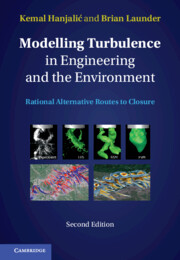Refine search
Actions for selected content:
5487 results in Thermal-fluids engineering
References
-
- Book:
- Modelling Turbulence in Engineering and the Environment
- Published online:
- 03 November 2022
- Print publication:
- 24 November 2022, pp 464-497
-
- Chapter
- Export citation
9 - RANS modelling of unsteady flows (URANS)
-
- Book:
- Modelling Turbulence in Engineering and the Environment
- Published online:
- 03 November 2022
- Print publication:
- 24 November 2022, pp 332-370
-
- Chapter
- Export citation
Index
-
- Book:
- Modelling Turbulence in Engineering and the Environment
- Published online:
- 03 November 2022
- Print publication:
- 24 November 2022, pp 498-506
-
- Chapter
- Export citation
5 - Modelling the scale-determining equations
-
- Book:
- Modelling Turbulence in Engineering and the Environment
- Published online:
- 03 November 2022
- Print publication:
- 24 November 2022, pp 140-156
-
- Chapter
- Export citation
3 - Characterization of stress and flux dynamics: elements required for modelling
-
- Book:
- Modelling Turbulence in Engineering and the Environment
- Published online:
- 03 November 2022
- Print publication:
- 24 November 2022, pp 33-58
-
- Chapter
- Export citation

Modelling Turbulence in Engineering and the Environment
- Rational Alternative Routes to Closure
-
- Published online:
- 03 November 2022
- Print publication:
- 24 November 2022
Part III - The Finite Volume Method
-
- Book:
- Finite Element and Finite Volume Methods for Heat Transfer and Fluid Dynamics
- Published online:
- 27 January 2023
- Print publication:
- 27 October 2022, pp 215-372
-
- Chapter
- Export citation
Part I - Preliminaries
-
- Book:
- Finite Element and Finite Volume Methods for Heat Transfer and Fluid Dynamics
- Published online:
- 27 January 2023
- Print publication:
- 27 October 2022, pp 1-90
-
- Chapter
- Export citation
7 - The Finite Volume Method: Diffusion Problems
- from Part III - The Finite Volume Method
-
- Book:
- Finite Element and Finite Volume Methods for Heat Transfer and Fluid Dynamics
- Published online:
- 27 January 2023
- Print publication:
- 27 October 2022, pp 217-268
-
- Chapter
- Export citation
Preface
-
- Book:
- Finite Element and Finite Volume Methods for Heat Transfer and Fluid Dynamics
- Published online:
- 27 January 2023
- Print publication:
- 27 October 2022, pp xi-xiii
-
- Chapter
- Export citation
9 - Finite Volume Methods for Viscous Incompressible Flows
- from Part III - The Finite Volume Method
-
- Book:
- Finite Element and Finite Volume Methods for Heat Transfer and Fluid Dynamics
- Published online:
- 27 January 2023
- Print publication:
- 27 October 2022, pp 295-346
-
- Chapter
- Export citation
5 - The Finite Element Method: Unsteady Heat Transfer
- from Part II - The Finite Element Method
-
- Book:
- Finite Element and Finite Volume Methods for Heat Transfer and Fluid Dynamics
- Published online:
- 27 January 2023
- Print publication:
- 27 October 2022, pp 153-178
-
- Chapter
- Export citation
3 - Solution Methods for Algebraic Equations
- from Part I - Preliminaries
-
- Book:
- Finite Element and Finite Volume Methods for Heat Transfer and Fluid Dynamics
- Published online:
- 27 January 2023
- Print publication:
- 27 October 2022, pp 63-90
-
- Chapter
- Export citation
References
-
- Book:
- Finite Element and Finite Volume Methods for Heat Transfer and Fluid Dynamics
- Published online:
- 27 January 2023
- Print publication:
- 27 October 2022, pp 373-380
-
- Chapter
- Export citation
Symbols
-
- Book:
- Finite Element and Finite Volume Methods for Heat Transfer and Fluid Dynamics
- Published online:
- 27 January 2023
- Print publication:
- 27 October 2022, pp xv-xviii
-
- Chapter
- Export citation
Index
-
- Book:
- Finite Element and Finite Volume Methods for Heat Transfer and Fluid Dynamics
- Published online:
- 27 January 2023
- Print publication:
- 27 October 2022, pp 381-386
-
- Chapter
- Export citation
Dedication
-
- Book:
- Finite Element and Finite Volume Methods for Heat Transfer and Fluid Dynamics
- Published online:
- 27 January 2023
- Print publication:
- 27 October 2022, pp xiv-xiv
-
- Chapter
- Export citation
Copyright page
-
- Book:
- Finite Element and Finite Volume Methods for Heat Transfer and Fluid Dynamics
- Published online:
- 27 January 2023
- Print publication:
- 27 October 2022, pp iv-iv
-
- Chapter
- Export citation
Part II - The Finite Element Method
-
- Book:
- Finite Element and Finite Volume Methods for Heat Transfer and Fluid Dynamics
- Published online:
- 27 January 2023
- Print publication:
- 27 October 2022, pp 91-214
-
- Chapter
- Export citation
6 - Finite Element Analysis of Viscous Incompressible Flows
- from Part II - The Finite Element Method
-
- Book:
- Finite Element and Finite Volume Methods for Heat Transfer and Fluid Dynamics
- Published online:
- 27 January 2023
- Print publication:
- 27 October 2022, pp 179-214
-
- Chapter
- Export citation
